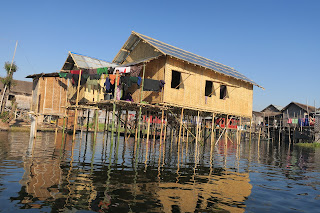Fish caught from the lake - the most abundant kind is called nga hpein locally (Inle carp, Cyprinus intha) - are a staple of the local diet. A popular local dish is htamin gyin - 'fermented' rice kneaded with fish and/or potato - served with hnapyan gyaw (literally twice fried - Shan tofu).
In addition to fishing, locals grow vegetables and fruit in large gardens that float on the surface of the lake. The floating garden beds are formed by extensive manual labor.
The farmers gather up lake-bottom weeds from the deeper parts of the lake, bring them back in boats and make them into floating beds in their garden areas, anchored by bamboo poles. These gardens rise and fall with changes in the water level, and so are resistant to flooding. The constant availability of nutrient-laden water results in these gardens being incredibly fertile. Rice cultivation and consumption is also significant facet of the local diet and agricultural tradition.
|
Fisherman about to drop his net. |
|
Fisherman collecting his net. |
|
Fisherman setting traps for fish in the lake. |
|
Fisherman collecting seafood from traps. |
|
Fisherman collecting weeds from the bottom of the lake. |
|
Fishermen carrying the weeds to the floating gardens. |
|
Karaweik barge.
|
|
Typical Inle lake house.
|
See also
Source
Location















